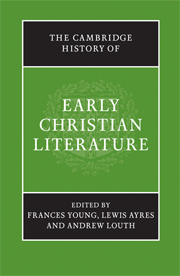Book contents
- Frontmatter
- PART ONE The Beginnings: The New Testament to Irenaeus
- PART TWO THE THIRD CENTURY
- PART THREE FOUNDATION OF A NEW CULTURE: FROM DIOCLETIAN TO CYRIL
- A LITERARY GUIDE
- 21 Classical genres in Christian guise; Christian genres in classical guise
- 22 Arnobius and Lactantius
- 23 Eusebius and the birth of church history
- 24 The fourth-century Alexandrians: Athanasius and Didymus
- 25 Palestine: Cyril of Jerusalem and Epiphanius
- 26 The Cappadocians
- 27 Fourth-century Latin writers: Hilary, Victorinus, Ambrosiaster, Ambrose
- 28 Jerome and Rufinus
- 29 Augustine
- 30 John Chrysostom and the Antiochene School to Theodoret of Cyrrhus
- 31 Cyril of Alexandria
- 32 Hagiography
- 33 Ephrem and the Syriac Tradition
- 34 The literature of the monastic movement
- 35 Women and words: texts by and about women
- 36 Conciliar records and canons
- B CONTEXT AND INTERPRETATION
- Bibliographies
- Index
- Map: The Roman Empire in the late fourth century AD"
- References
24 - The fourth-century Alexandrians: Athanasius and Didymus
from A - LITERARY GUIDE
Published online by Cambridge University Press: 28 March 2008
- Frontmatter
- PART ONE The Beginnings: The New Testament to Irenaeus
- PART TWO THE THIRD CENTURY
- PART THREE FOUNDATION OF A NEW CULTURE: FROM DIOCLETIAN TO CYRIL
- A LITERARY GUIDE
- 21 Classical genres in Christian guise; Christian genres in classical guise
- 22 Arnobius and Lactantius
- 23 Eusebius and the birth of church history
- 24 The fourth-century Alexandrians: Athanasius and Didymus
- 25 Palestine: Cyril of Jerusalem and Epiphanius
- 26 The Cappadocians
- 27 Fourth-century Latin writers: Hilary, Victorinus, Ambrosiaster, Ambrose
- 28 Jerome and Rufinus
- 29 Augustine
- 30 John Chrysostom and the Antiochene School to Theodoret of Cyrrhus
- 31 Cyril of Alexandria
- 32 Hagiography
- 33 Ephrem and the Syriac Tradition
- 34 The literature of the monastic movement
- 35 Women and words: texts by and about women
- 36 Conciliar records and canons
- B CONTEXT AND INTERPRETATION
- Bibliographies
- Index
- Map: The Roman Empire in the late fourth century AD"
- References
Summary
Fourth-century Alexandrian theology is more or less summed up in the writings of two theological giants, Athanasius, pope of Alexandria from 328 until his death in 373 (not counting various periods of deposition and exile), and Didymus the Blind, a scholar of enormous renown in his own day, who was appointed head of the Catechetical School in Alexandria by Athanasius, a position he held until his death. The contrast that will be revealed between their theological methods and teaching suggests that, although Didymus taught with the approval and support of Athanasius, it is hazardous to speak too confidently of an ‘Alexandrian school of theology’.
Athanasius
Since Athanasius’ election as bishop of Alexandria in 328 was challenged on canonical grounds, it is likely that he had then barely attained the canonical age of thirty, which would mean that he was born at the very end of the third century. We know nothing about his upbringing and education, though from his writings it would seem a fair deduction that he acquired a good knowledge of Greek, without having had a formal education. His knowledge of classical philosophy and rhetoric is far from non-existent: he has a genuine admiration for Plato, whom he calls ‘great among the Greeks’, and shows skill in rhetorical methods of argument, but his style (of writing, as well as thinking) has a simple home-spun quality. He must soon have attracted the attention of the pope of Alexandria, or his circle, for already in his twenties he became one of his deacons, and attended the Council of Nicaea with Alexander (325).
Keywords
- Type
- Chapter
- Information
- The Cambridge History of Early Christian Literature , pp. 275 - 282Publisher: Cambridge University PressPrint publication year: 2004
References
- 1
- Cited by



